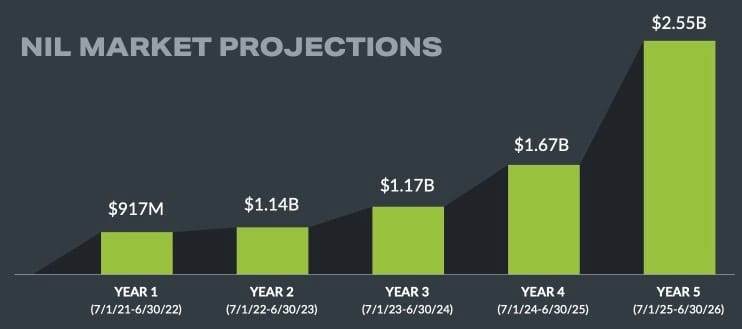
Later this week, it is expected that a court will stamp the House vs. NCAA settlement, opening the door for a $20.5 million annual salary cap at major college programs.
If approved - with some last-minute hangups adding just an air of uncertainty to things - this will have significant ramifications on youth sports, as the labor market for professional sports “jobs” in the United States increases by upwards of 10% overnight.
Let’s walk through it, and identify the opportunities and potential drawbacks of the settlement.
📈 Pro Sports TAM Increases
Initially, the power conference schools will be required to participate in the settlement, with other D1 schools likely to join in on the fun.
Estimates are that about 120 schools will participate and pay $20 billion to student athletes over the next 10 years— or about $2 billion per year, maybe more depending on how many schools join and spend up to the cap.
That will create an entirely new labor market for college athletes nearly the size of the EPL and NHL, and much larger than MLS.
Some rough math on combined league payrolls and where the NCAA will stack up:
League | Teams | Salary Cap / Avg Payroll per Team | Total Annual Player Pay |
|---|---|---|---|
NFL | 32 | $255.4M salary cap | ~$8.2B (32 × $255.4M) |
MLB | 30 | ~$169.5M avg payroll | ~$5.1B (30 × $169.5M) |
NBA | 30 | $140.6M salary cap | ~$4.2B (30 × $140.6M) |
NHL | 32 | $88M salary cap | ~$2.8B (32 × $88M) |
NCAA (Projected) | ~130 | ~$15M per school (est.) | ~$2.0B (130 × $15M) |
MLS | 30 | ~$5.95M soft cap | ~$0.3B |
EPL | 20 | varies | ~$2.7B |
For NCAA athletes, these direct payments are in addition to scholarship values and NIL deals— though NIL deals over $600 will have to go through a clearinghouse to make sure they are “market rate” and legitimate.
How much incremental money enters the system is up for debate. But numbers from Opendorse, an NIL platform, peg the current NIL market at $1.67B, and expect it to “exceed $2.5B” in the first year of direct payments, and likely rocket much higher.

Opendorse data
The role of the NIL collective for roster formation, which had been doling out 81% of all NIL money, according to the report, will be greatly reduced since schools can just pay the players directly— but collectives will still play a vital role in compensating athletes through sponsorship opportunities.
How will this actually play out?
Become a Buying Sandlot Premium Member to read the rest
The only community built solely for youth sports professionals
Upgrade nowA subscription gets you:
- EXCLUSIVE REPORTS Get access to deep dives and segment-specific benchmarking reports— the only place to get this level of on-the-ground data in the rapidly changing world of youth sports
- COMMUNITY ACCESS Engage with leading facility operators, event and tournament hosts, league and team admins, tech founders, and investors in a private Slack group
- INVESTMENT OPPORTUNITIES Find and list investment and acquisition opportunities in youth sports
- FREE ADVERTISING IN A BUYING SANDLOT NEWSLETTER Promote your business, product, or service to over 4,500 youth sports professionals
- IN-PERSON EVENTS Early invites to private, in-person roundtables and discounts on future Buying Sandlot events

